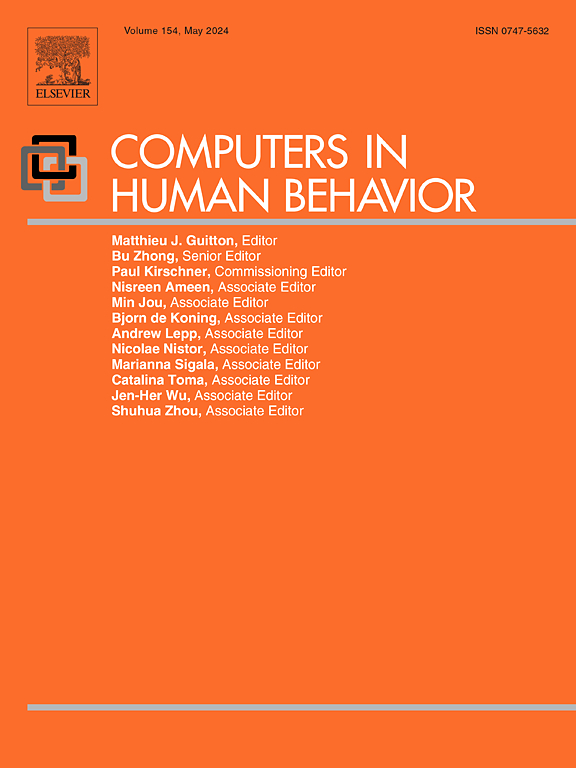解析媒体渠道对人工智能感知的影响:中国用户跨渠道、过载、素养和焦虑的人工智能信息暴露的网络分析
IF 8.9
1区 心理学
Q1 PSYCHOLOGY, EXPERIMENTAL
引用次数: 0
摘要
人工智能(AI)发展迅速,引起了越来越多的公众关注。虽然网上有关人工智能的信息提高了人们的技术意识,但它也可能引发焦虑。在人工智能应用正在加速的中国,不同媒体渠道对人工智能信息传播的心理影响仍未得到充分探索。本研究在中国大陆进行了一项横断面调查(n = 1371),测量了在线人工智能信息扫描、信息过载、人工智能素养和人工智能焦虑。使用EBICglasso方法的网络分析检查了这些变量之间的关联,并确定了中心节点和桥接节点。结果显示,不同媒体渠道之间存在不同的关联。虽然大多数媒体渠道都与人工智能素养和人工智能信息过载呈正相关,但这些关联的强度各不相同。短视频和社交媒体在促进人工智能素养方面最为显著,而在线音频曝光与人工智能信息过载表现出最强烈的正相关。人工智能素养(作为抑制剂)和人工智能信息过载(作为压力源)在媒介暴露与人工智能焦虑维度之间的关系中发挥相反的作用,读写能力减轻焦虑,过载加剧焦虑。特定媒体渠道与人工智能焦虑的不同维度之间的关联也存在差异。此外,中心性分析发现,社会技术盲目性焦虑是最具影响力的节点,人工智能学习焦虑是跨社区的关键桥梁。这项研究首次应用网络分析来研究人工智能信息扫描、过载、读写能力和焦虑之间的维度相互关系。研究结果强调了人工智能传播对特定渠道的影响,并为通过有针对性的媒体策略减轻公众对人工智能的焦虑提供了实际意义。本文章由计算机程序翻译,如有差异,请以英文原文为准。
Unpacking media channel effects on AI perception: A network analysis of AI information exposure across channels, overload, literacy, and anxiety among Chinese users
Artificial intelligence (AI) has developed rapidly and attracted growing public attention. While online information regarding AI promotes technological awareness, it may also trigger anxiety. In China, where AI adoption is accelerating, the psychological effects of different media channels for AI information communication remain underexplored. This study employed a cross-sectional survey across mainland China (n = 1371), measuring online AI information scanning, information overload, AI literacy, and AI anxiety. Network analysis using the EBICglasso method examined associations among these variables and identified central and bridging nodes. Results revealed diverse associations across media channels. While most media channels were positively associated with both AI literacy and AI information overload, the strength of these associations varied. Short-video and social media were the most significant in promoting AI literacy, whereas online audio exposure showed the strongest positive association with AI information overload. AI literacy (as an inhibitor) and AI information overload (as a stressor) played opposing roles in mediating the relationship between media exposure and dimensions of AI anxiety, with literacy mitigating and overload exacerbating anxiety. The associations between specific media channels and different dimensions of AI anxiety also differed. Furthermore, centrality analysis identified sociotechnical blindness anxiety as the most influential node and AI learning anxiety as a key bridge across communities. This study is the first to apply network analysis to examine dimensional interrelations among AI information scanning, overload, literacy, and anxiety. Findings highlight the channel-specific impacts of AI communication and offer practical implications for mitigating public AI anxiety through targeted media strategies.
求助全文
通过发布文献求助,成功后即可免费获取论文全文。
去求助
来源期刊

Computers in Human Behavior
Multiple-
CiteScore
19.10
自引率
4.00%
发文量
381
审稿时长
40 days
期刊介绍:
Computers in Human Behavior is a scholarly journal that explores the psychological aspects of computer use. It covers original theoretical works, research reports, literature reviews, and software and book reviews. The journal examines both the use of computers in psychology, psychiatry, and related fields, and the psychological impact of computer use on individuals, groups, and society. Articles discuss topics such as professional practice, training, research, human development, learning, cognition, personality, and social interactions. It focuses on human interactions with computers, considering the computer as a medium through which human behaviors are shaped and expressed. Professionals interested in the psychological aspects of computer use will find this journal valuable, even with limited knowledge of computers.
 求助内容:
求助内容: 应助结果提醒方式:
应助结果提醒方式:


